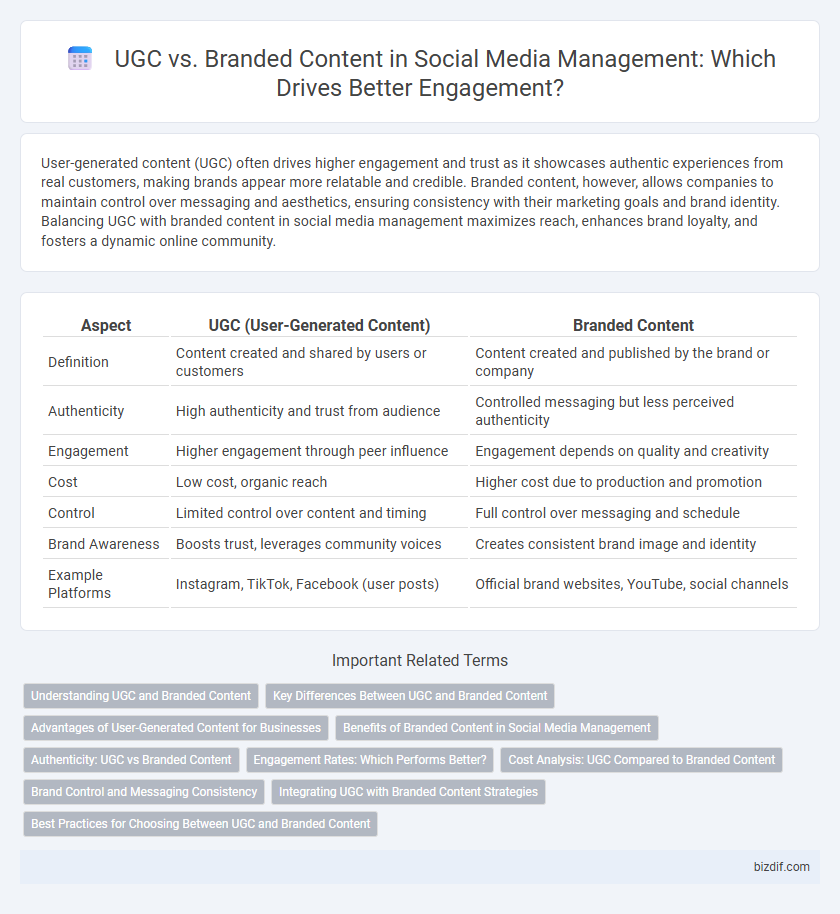User-generated content (UGC) often drives higher engagement and trust as it showcases authentic experiences from real customers, making brands appear more relatable and credible. Branded content, however, allows companies to maintain control over messaging and aesthetics, ensuring consistency with their marketing goals and brand identity. Balancing UGC with branded content in social media management maximizes reach, enhances brand loyalty, and fosters a dynamic online community.
Table of Comparison
| Aspect | UGC (User-Generated Content) | Branded Content |
|---|---|---|
| Definition | Content created and shared by users or customers | Content created and published by the brand or company |
| Authenticity | High authenticity and trust from audience | Controlled messaging but less perceived authenticity |
| Engagement | Higher engagement through peer influence | Engagement depends on quality and creativity |
| Cost | Low cost, organic reach | Higher cost due to production and promotion |
| Control | Limited control over content and timing | Full control over messaging and schedule |
| Brand Awareness | Boosts trust, leverages community voices | Creates consistent brand image and identity |
| Example Platforms | Instagram, TikTok, Facebook (user posts) | Official brand websites, YouTube, social channels |
Understanding UGC and Branded Content
User-Generated Content (UGC) refers to authentic, unpaid content created by consumers, enhancing trust and engagement on social media platforms. Branded content is professionally produced marketing material designed to promote a brand's message and values while maintaining entertainment or informational appeal. Understanding the differences between UGC and branded content is essential for effective social media management, as leveraging both appropriately can maximize reach and foster stronger community connections.
Key Differences Between UGC and Branded Content
User-Generated Content (UGC) originates from consumers and reflects authentic brand experiences, while branded content is created by businesses to strategically promote their products or services. UGC often drives higher engagement and trust due to its genuine nature, whereas branded content offers controlled messaging and consistent brand identity. Key differences include source authenticity, content control, and the impact on audience perception during social media campaigns.
Advantages of User-Generated Content for Businesses
User-generated content (UGC) boosts brand authenticity by showcasing real customer experiences that build trust and encourage engagement. It significantly reduces content creation costs while expanding organic reach through shares and authentic interactions. UGC also enhances SEO performance by increasing diverse content and keyword-rich posts across social media platforms.
Benefits of Branded Content in Social Media Management
Branded content in social media management enhances brand authority and fosters deeper audience engagement through authentic storytelling aligned with brand values. It allows precise targeting and increased trust by seamlessly integrating promotional messages within valuable, relevant content. This approach drives higher conversion rates and brand loyalty compared to traditional advertising or generic user-generated content (UGC).
Authenticity: UGC vs Branded Content
User-Generated Content (UGC) offers unparalleled authenticity as it showcases real customer experiences and genuine opinions, fostering stronger trust among audiences. In contrast, branded content, while polished and strategically crafted, often lacks the spontaneous and relatable qualities that drive emotional connections. Leveraging UGC in social media management enhances brand credibility by highlighting authentic voices that resonate more deeply with target communities.
Engagement Rates: Which Performs Better?
User-generated content (UGC) typically yields higher engagement rates than branded content due to its authentic and relatable nature, fostering trust and community interaction. Studies show UGC posts can generate up to 28% more engagement on platforms like Instagram and Facebook compared to traditional branded content. Brands leveraging UGC often benefit from increased shares, comments, and overall organic reach, enhancing their social media performance efficiently.
Cost Analysis: UGC Compared to Branded Content
User-generated content (UGC) significantly reduces costs compared to branded content by leveraging organic consumer creations that require minimal production expenses. Branded content involves higher investments in professional design, scripting, and paid media placements, leading to increased overall marketing budgets. Analyzing cost-effectiveness, UGC delivers authentic engagement with lower resource allocation, making it a budget-friendly choice for scalable social media campaigns.
Brand Control and Messaging Consistency
User-generated content (UGC) offers authentic audience engagement but limits brand control and messaging consistency, as content reflects diverse individual voices. Branded content ensures strict oversight over brand identity, maintaining uniform messaging and visual standards across platforms. Leveraging branded content facilitates precise communication strategies essential for strong brand positioning in social media management.
Integrating UGC with Branded Content Strategies
Integrating user-generated content (UGC) with branded content strategies enhances authenticity and boosts audience engagement by leveraging real customer experiences alongside polished brand messaging. Effective social media management involves curating UGC that aligns with brand values and seamlessly incorporates it into campaigns to increase trust and social proof. Combining both elements drives higher conversion rates and creates a dynamic, relatable narrative that resonates with target audiences across platforms.
Best Practices for Choosing Between UGC and Branded Content
User-generated content (UGC) boosts authenticity and engagement by showcasing real customer experiences, making it ideal for building trust and community on social media platforms. Branded content allows precise message control and consistent brand identity, critical for campaigns focused on product launches or targeted marketing goals. Balancing UGC and branded content through clear guidelines, audience insights, and performance metrics optimizes social media strategy and enhances overall brand impact.
UGC vs branded content Infographic

 bizdif.com
bizdif.com